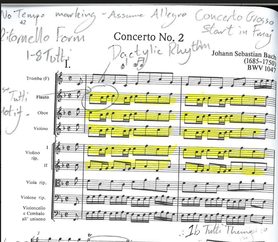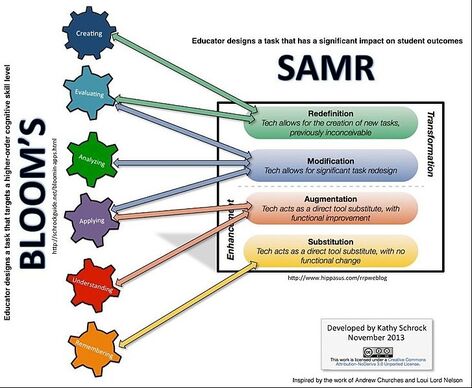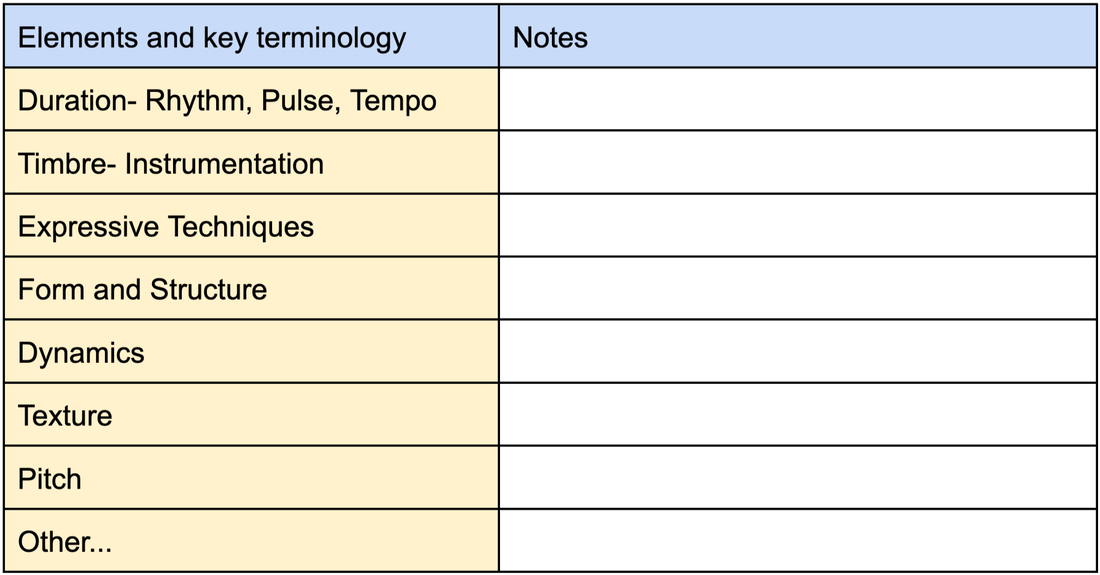|
The ATL skills are the foundations of IB MYP education. Developing the skills ensures students are learning how to learn so they are adaptable for lifelong learning. These skills of Communication, Research, Self Management, Social and Thinking are applied in a wide variety of situations in MYP Music. Throughout the last couple of years, I have made a conscious effort to be more explicit in my teaching of them to ensure students recognise and reflect on the skills that they are developing. More importantly how they can use those skills in a variety of situations.
With the help of AI and some editing. I have produced this poster on some of the ATL skills and how they are applied in Music. Please feel free to use and share amongst the community under creative commons usage.
1 Comment
 Example of note-taking on a score. Example of note-taking on a score. There are several different approaches to analysing music. what is important is to show a deep understanding of the music, analyse, discuss and evaluate what is happening in the music. This aims to look at some of the basics. Listen to music. Can you pick out any key detail from your first listen to the music? When discussing what is happening in the music, quite often students can miss out on the obvious. Start with what stands out in the music, what kind of mood and tone is the music set out to have? Which instruments are taking the lead? What is particularly interesting about the music? Use a score and make notes Ensure you have a score and make notes of what you think is happening in the music. Make references to specific parts of the music that interest you. Use highlighters and a range of colours for different themes, motifs or sections. You will need to refer to the score and bar numbers in your writing. (See example). If you do not have a score, make a graphical score. It helps you to visualise the music and see how all the elements fit together. You don’t have to be a great artist to make one. Add timing marks so you know what is happening and when. Generate-Sort-Connect-Elaborate This is a project zero thinking routine I like to use when starting a musical analysis and writing about music. (Harvard School of Education, 2016)
DR (CP) SMITH This is a handy mnemonic to remember as it helps to ensure that the basic elements of music have been covered for discussion. Each of the letters stands for a different element of music. The CP in the middle is optional and stands for Context and Purpose, to help contextualise and understand the meaning of the music. DR CP SMITH stands for
Get an IDEA Another useful analysis tool I have used in music and inspired by Samuel Wright (2021) in Music for the IB MYP 4&5. The strategic listening idea is to get an IDEA. Identify, Describe, Explain and Analyse. This also helps to provide a good framework for writing more in-depth about the music. Identify sounds and patterns you hear. Describe how they are being played, presented or layered Explain what role they play in the structure of the work Analyse the smaller parts (intervals, motifs, sequences, to their outward larger parts of the form, modulations, phrases and cadences. (Wright, 2020) Use a table/template to organise your thoughts and ideas Using a table is another way to help organise ideas. Also helps with being able to organise, thoughts and ideas to be able to discuss them in the assignment. One example is below of a template we use in class. Plan your paper
If you are writing to a question, highlight the keywords in the question to understand exactly what the question is asking you. It is easy in a question to start talking about the context rather than showing your understanding of the music itself. For example, in a paper on the use of themes in the Brandenburg Concerto no.2, half of the paper is on the story of Bach’s life. Talk about the music and talk about the context of the music if it serves to answer the purpose of the music. Kelly (2011) highlights when analysing music “Ultimately, you will need to select, organise, and explain fully only those musical details that connect to your argument.” Avoid a play by play analysis too. It is natural to lend yourself to analyse as you listen through the piece, but it does not lend itself to high levels of critical thinking and analysis. Instead, focus on the key points you want to make and find examples in different parts of the music to reinforce your argument. Think about the key points you want to make and be sure to reference either bar numbers or timings in the piece. Think about the purpose of the music and hypothesise, analyse, discuss, and evaluate. There is no such thing as a completely correct answer, but there is an insightful and well thought out answer backed with evidence. Use terminology and build your vocabulary. It is easy to write a lot describing what is happening in the music when there is already a term that describes it. I would recommend the oxford music dictionary of terms. It is useful for remembering tricky musical terms. My copy got me through University, my masters and my career as a music teacher. Also, practice on tools like Quizlet to build an understanding of the common terms that are used. References: Kelly, T.F. (2011) Writing about music: A guide to writing in A & I 24. Available at: http://writingproject.fas.harvard.edu/files/hwp/files/ai_24_guide_to_print.pdf (Accessed: 14 January 2022). Harvard School of Education (2016) Generate, Sort, Connect and Elaborate. Available at: http://www.pz.harvard.edu/resources/generate-sort-connect-elaborate (Accessed: 14 January 2022) Wright, S. (2021) Music for the IB MYP 4&5: MYP by Concept, Hodder Education, London  Before considering how much music technology should be integrated into music lessons, it must be first considered what the objectives of music education are and what we want it to look like. For myself, music education should be inclusive, where all students of different backgrounds and abilities can be involved in music and be able to perform and create. Technology allows teachers to create opportunities for learning for all students, it also allows students to be autonomous in their learning to allow for inquiry, authentic learning and skill development. This is where Richard Gill (2016) said that in music education there is not one size that fits all and we should not teaching one style of music. Music is also consumed by people differently as many more people are using streaming services and especially during the Co-Vid 19 pandemic (Westcott Grant, 2020) This has also meant the way we teach music has been different and we have had to rely on technology to give students any form of music education. From personal experience, having to rely on technology so quickly lead to a lot of problems, and having to share ideas, problems and solutions with other teachers going through the same process. Going through the pandemic had given me a better understanding of music education. The most successful projects we encountered with teaching online involved working as a community and collaboration. Programs like Soundtrap were more successful than GarageBand for the reason that students could collaborate on the same project. Also, as a teacher, I could drop in on a project at any time. See the conversations and give immediate feedback. I believe that the technology programs that allow a level of collaboration and allow development for various levels are the most successful. Moreover the experience of music is charging and is different. Bauer (2014) highlights that students can have a more ‘do it yourself’ attitude to learning through technology, that they can make music using mobile technologies and online. What can follow is that students develop through constructed and experiential learning. From understanding the learning objectives of the students, it follows three understanding of what the technology can be used for. The SAMR (Substitution, Augmentation, Modification and Redefinition) model is useful in categorising and understanding the types of music technology in their varied forms (Puentedura, 2008.) From Schrock’s (2013) visualisation we can see how it is a useful tool to relate to other critical and creative thinking models such as Blooms. Purely using technology to substitute or augment tasks, function within the lower orders of critical thinking. Where technology has new functionality where it is modified or redesigned, it allows students to access the higher order thinking skills such as analysing, evaluating and creating. This is why initiatives like maker-spaces are so exciting because it allows students to problem solve and be more critical in their learning. Therefore when looking at the technology we use we should consider how are we going to make students use their higher lieder critical thinking skills as well as developing performing and creating skills which are equally important in music. Bauer, W. (2014) Music learning and technology. New Directions: A Journal of Scholarship, Creativity, and Leadership in Music Education 1 (1). Available at: http://nd.music.msu.edu/music-learning-technology-william-bauer/ Accessed on: 1st August 2020 Puentedura, R. (2008). TPCK and SAMR: Models for enhancing technology integration. In, As we may teach: Educational technology, from theory into practice. Maine Department of Education. Schrock, K. (2013) SAMR Model and Bloom's Educators design. Available at: http://www.schrockguide.net/uploads/3/9/2/2/392267/2797403_orig.jpg Accessed on: 1st August 2020 The University of Sydney (2016) The Place of Music in 21st Century Education. Available at: https://coursera.org/share/756064bb20bc2b5141b902b7e6011188 Accessed on: 31st July 2020 Westcott Grant, K (2020) The Future Of Music Streaming: How COVID-19 Has Amplified Emerging Forms Of Music Consumption. Available at: https://www.forbes.com/sites/kristinwestcottgrant/2020/05/16/the-future-of-music-streaming-how-covid-19-has-amplified-emerging-forms-of-music-consumption/#43fbf7b0444a Accessed on: 1st August 2020 The video from Richard Gill (2016a) provoked some interesting ideas on how to approach music. That students first need to fall in love with music before anything else. That students from a young age should start singing to appreciate music but also learn about melody, rhythm and that making music is being part of a community.
What was also fascinating that Richard Gill said is about understanding the value of music from Lady Ga-Ga to Mozart that we should start from the music that students love but expand to let students learn and improve themselves. To quote “A lot of people say, I know how we'll get to these kids, we'll do pop music all day, every day. Nothing wrong with pop music, but it's a bit like saying, I know how to feed these children. We're going to give them Mars bars every day.” Meaning that there is great value in pop music but there is a whole wealth of music to explore. Therefore, as educators, we should encourage students to find their own path in music. There isn’t one option, there isn’t one repertoire for students to follow that is the correct way to teach music. The musician Francis Xavier(2016b) in the video shows how he was introduced to creating music by the community he was involved in and that music is made through sharing ideas and breeding creativity. In Lucy Green’s book ‘Music, Informal Learning and the School: A New Classroom Pedagogy’ (2008) she talks about how informal learning by learning in friendship groups is a more authentic way of learning and students respond better to this way of learning. What happens is that students are able to see and understand why this way of learning is relevant to themselves and the impact it can have on themselves to create something worthwhile. That the tasks set are not arbitrary but instead exciting and engaging. Green, L. (2008). Music, informal learning and the school: A new classroom pedagogy. Aldershot, England: Ashgate Publishing Ltd. The University of Sydney (2016a) The Place of Music in 21st Century Education. Available at: https://coursera.org/share/756064bb20bc2b5141b902b7e6011188 Accessed On 31st July 2020 The University of Sydney (2016b) The Place of Music in 21st Century Education. Available at: https://coursera.org/share/6d292c233bf19e3d8e1382c2250ff561 Accessed On 31st July 2020
OnTask 1 - Online MOOC
Outlining your position on the question of how much technology and the cultures around digital technology should influence education, and music education, in the 21st Century. My response For myself, music education embraces technology because it makes music more accessible to students of all ages and abilities. Just like the first video in the course from Northern Beaches Christian School in Australia they promote mixing year groups to extend the learning of younger students and the consolidation of learning for older students (The University of Sydney, 2007a). What was fantastic is that students could work at their own pace in their own time to create and perform music. What was also great was space that was designed to be flexible for the learner. The learner has the opportunity to use the space in order of they want to create. This is what I aspire to do my own classroom, to create pockets of spaces that the learner can go into to work independently or collaboratively with others to create music. Moreover, in the second video, they explain that there is a consistency of learning and the learning style over six years (The University of Sydney, 2007b). Providing consistency of education over six is great for giving students a steady and consistent pathway for learning and creating. Also to develop skills and knowledge over a course of time. In contrast, the Steiner style of education is also appealing because of the sense of community it brings to learning(The University of Sydney, 2007c). With working as a community it gives the music a true essence of belonging and purpose within the culture of the school. Having no technology allows students to develop their skills such as listening, improvisation, performance and creativity differently than using music technology. They are able to carefully consider the arts and how they are applied into all of the classes. The students are allowed to express themselves and give their ideas. Also instilling pride and worth of what they are creating (Kamaroi Rudolf Steiner School, 2014). However, using music technology allows interaction with the modern world and for students to put their work in a domain that can produce endless possibilities. Kamaroi Rudolf Steiner School (2014) The Kamaroi Difference. Available at: https://vimeo.com/68889303 Accessed on: 24th July 2020 The University of Sydney (2016a) The Place of Music in 21st Century Education. Available at: https://coursera.org/share/52d33a1676c941bf8134af4438872ddc Accessed On 24th July 2020 The University of Sydney (2007b) The Place of Music in 21st Century Education. Available at: https://coursera.org/share/74e6922c3e7bb7510311d643d6f1a985 Accessed On 24th July 2020 The University of Sydney (2007c) The Place of Music in 21st Century Education. Available at: https://coursera.org/share/bfeed9b00f3d4eb5dd71bfb4ac827ea3 Accessed On 24th July 2020 The Kamaroi Difference from RS Kamaroi on Vimeo. I have started a new online MOOc with Coursera about The Place of Music in 21st Century Education. Hopefully this will give great ideas to incorporate into the classroom. The G12 students are deep in studying their set works for the IB exam. Having completed the study of the Bach Brandenburg concerto. I thought it would be useful to do some open book exam questions with the G12 students and how to approach the section A question.
This is quite a general explanation of how to approach the question. However, the simple steps should help students develop their practices and focus their time when in a pressured environment. IB Music Section A, Exam Preparation - Strategies for Success,
Leaving the exam room do not dwell on what you have written. It is in the past, you can be safe in the knowledge you prepared the best you could, and you gave it all of your effort. By Christopher Hoddinott |
About meI am the Projects Coordinator and Senior School Music teacher at XCL World Academy in Singapore. I have over 10 year of IB teaching experience and working on bringing great learning experiences and opportunities to students. Archives
January 2022
Categories
All
|




 RSS Feed
RSS Feed
